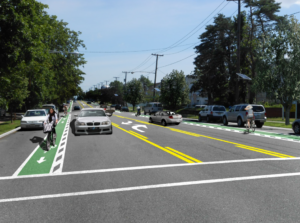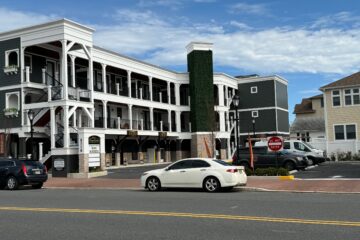By NANETTE LoBIONDO GALLOWAY
MARGATE – As requested, the city’s engineer and police chief provided their recommendations to the Board of Commissioners Thursday, Jan. 21 regarding the proposed “road diet” on Atlantic Avenue. However, the commission delayed voting to implement the roadway reconfiguration until its next meeting on Feb. 4.
Several residents weighed in on the proposed plan to turn the roadway from four lanes into two lanes with a center turn lane and widened bike lanes.
Resident John Sewell said the idea was “crazy” and asked the commissioners to reconsider straddling taxpayers with the cost.
An octogenarian stumbling along at 10- or 15-miles-per-hour could back up traffic to the Longport bridge, he said.
“You’re inviting more problems. You should keep it open,” he said.
The change could negatively affect the already suffering business community and the city should not do anything to discourage tourism to Margate, he said.
Amy Reale, a 14-year resident who lives on Monmouth Avenue, said she fears the road diet would cause a bottleneck on Atlantic Avenue and that frustrated visitors to the city would try to avoid it by using through streets on the western side of the city.
“All of these changes are negatively affecting year-round residents and favoring summer residents,” she said.
Former Mayor Vaughan Reale asked what benchmark the city would use to determine the road diet’s success, if the city would be pursuing the change if it were not the recipient of state aid, and how much it would cost to reverse it if the city decided it was not satisfied with the improvement.
“If we could take the money and put it on actual traffic lights that control the intersections, it might be money better spent,” he said.
Mayor Michael Becker repeated his often said refrain that the public comment period is not a question and answer session, and that someone would contact Reale with answers to his questions.
Resident Joe Caponini commended the commission for considering the change and said the effort was “long overdue.”
Engineer Ed Dennis of Remington & Vernick, who conducted two online public information sessions in December explaining the road diet and soliciting feedback, said in a Jan. 19 memo to the mayor and commissioners that the benefits of the road diet is well-documented by the NJ Department of Transportation and Federal Highway Administration, including reducing crashes, speed, improved mobility and enhanced safety for all road users.
The road diet has been discussed since 2016 when Urban Engineers presented the Ventnor-Margate Bicycle and Pedestrian Plan and recommended a road diet for both communities on Atlantic Avenue.
According to Ventnor Commissioner of Public Works Lance Landgraf, the Ventnor commissioners will discuss the issue at its next meeting. Longport Borough implemented a road diet years ago, and Atlantic City is scheduled to do it soon.
“As stated in the Traffic Analysis Methodology Report completed in September 2020 by our office, we recommend that the City of Margate move forward with the proposed road diet on Atlantic Avenue,” Dennis said in his memo.
Police Chief Matthew Hankinson said “Casey’s Law,” which was approved in April 2010 after 21-year-old Casey Feldman was killed crossing the street in Ocean City, gives pedestrians the right of way at all intersections. That coupled with the four-lane roadway configuration, makes it “extremely unsafe” for pedestrians.
“I’m not a fan of the pedestrian crosswalk law,” Commissioner Maury Blumberg said. “That law has emboldened pedestrians to cross without looking and thinking.”
Although there have been no pedestrian fatalities on Atlantic Avenue, “we have many of the factors which have been shown to contribute to fatal motor vehicle accidents,” Hankinson said in a Jan. 18 letter to Administrator Richard Deaney.
The city has seen exponential growth in distracted driving, such as using cell phones, along with an increase in bicycle and pedestrian traffic in recent years, and there have been “close calls.” The road diet would give pedestrians and motorists “greater vision for any hazardous situations,” he said.
“This configuration would not only enhance pedestrian safety and allow for a wider and safer bicycle lane, but it would also create a roadway which is more efficient to those drivers who utilize it daily,” Hankinson said, recommending the city proceed with the project.
If the commissioners approve it, the work could be done before the summer season.
The project cost is estimated at $400,000, and the city received a $273,000 grant from the NJ DOT toward the cost.
Commissioner John Amodeo said he “totally supports” the project.
Blumberg said the city did as much as it could to educate the public about the proposal, and that he trusts the reports from professionals that indicate the road diet would not cause traffic backups.
“For me, there is no dollar value that can be placed on a human life. If this program prevents one accident and potentially saves one life, it’s worth the amount of money we will spend,” Blumberg said.
“I ran the gamut with this whole thing, but after extensive study and my major concerns for safety, I favor it strongly also,” Becker said.
The resolution for consideration at the Feb. 4 meeting will allow the city to advertise for bids for the project.
Copyright Mediawize, LLC 2021



